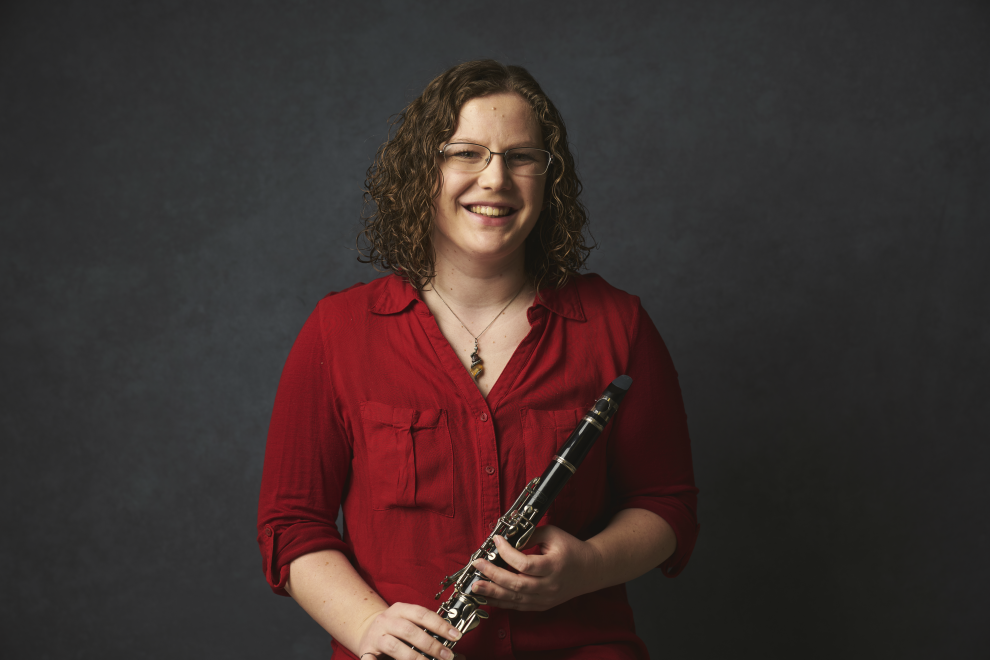Pump up the volume

April 25, 2018
For Larissa Taylor, engineering and music go hand in hand.
The second-year PhD student – who has been playing clarinet since elementary school – is passionate about finding ways to engineer hearing aids so that listening to music is as effortless as listening to someone talking.
“I’ve worn hearing aids myself for a really long time, and I’m used to them – but for music, they’re definitely a challenge because they’re set up to deal with speech,” she says. “The dynamic range of music is much wider than the range of speech, so the louds can be too loud and the softs can be too soft.”
Compressing that wide dynamic range within a hearing aid also leads to signal distortion, which can cause music to sound out of tune or otherwise unpleasant. And for Taylor, who plays with the Burlington-based Top Hats Marching Orchestra, balancing the volume of the band with hearing the conductor can be difficult.
As part of her work, Taylor has worked with McMaster’s LIVE (Large Interactive Virtual Environment) Lab holding events specifically designed for people who use hearing aids. One, in partnership with hearing aid manufacturer Unitron, measured listening effort in hearing aid users while they watched an improv performance.
More recently, Taylor was involved in a two-concert series at the LIVELab featuring the Madawaska String Quartet, where she and other researchers set up a number of different assistive listening devices to assess their effectiveness. About 40 hearing aid and cochlear implant users attended the concerts, which were held in conjunction with the McMaster Institute for Music and the Mind’s annual Neuromusic Conference – which was, appropriately, called “Do You Hear What I Hear: Perceiving Music with Hearing Loss.”
Assistive devices used at the concert included a telecoil loop, which is a loop of wire around the perimeter of a concert hall that transmits sound directly to hearing aids through a magnetic field – the way an old-fashioned telephone would work.
Patrons were also able to download an app to their phones, which would allow them to listen through headphones or directly with their hearing aids through a wireless connection. There was also an option to use an FM transmitter, which would send the signal over an FM system to wireless headphones that could be worn over hearing aids.
Taylor’s still compiling the data from the concerts, but says she’s made some interesting discoveries already.
“A lot of people didn’t even have a music program on their hearing aids, even though some companies do have those available,” she explains. “Obviously, that’s something we could try to change by talking to audiologists and making people aware that it’s an option. Also, a lot of hearing aids aren’t set up to work with a telecoil, because the technology isn’t used in phones anymore and it’s not common in North American concert halls.”
So there’s still a long way to go.
And while playing and listening to music with her hearing aids is challenging for Taylor, she’s never let it get in her way.
“People were always telling me, ‘You’re not going to be able to do music because it will be too hard,’ but I just did it anyway,” she laughs. “Hearing aids shouldn’t stop you from doing anything you want to do.”
In fact, solving challenging problems is exactly why Taylor, who has been an active member of the engineering community at Mac since she started her undergrad degree, got into engineering in the first place.
“I always knew that I liked math and science, and I liked that engineering was about problem solving,” she says. “I’d really like to see if I can make some sort of improvement to hearing aids – to be able to give people a better experience listening to music, even if it’s just a small change.”
This article is part of a series of profiles celebrating the 60th anniversary of McMaster’s Faculty of Engineering. For more Big Ideas stories, go to the faculty’s website.


